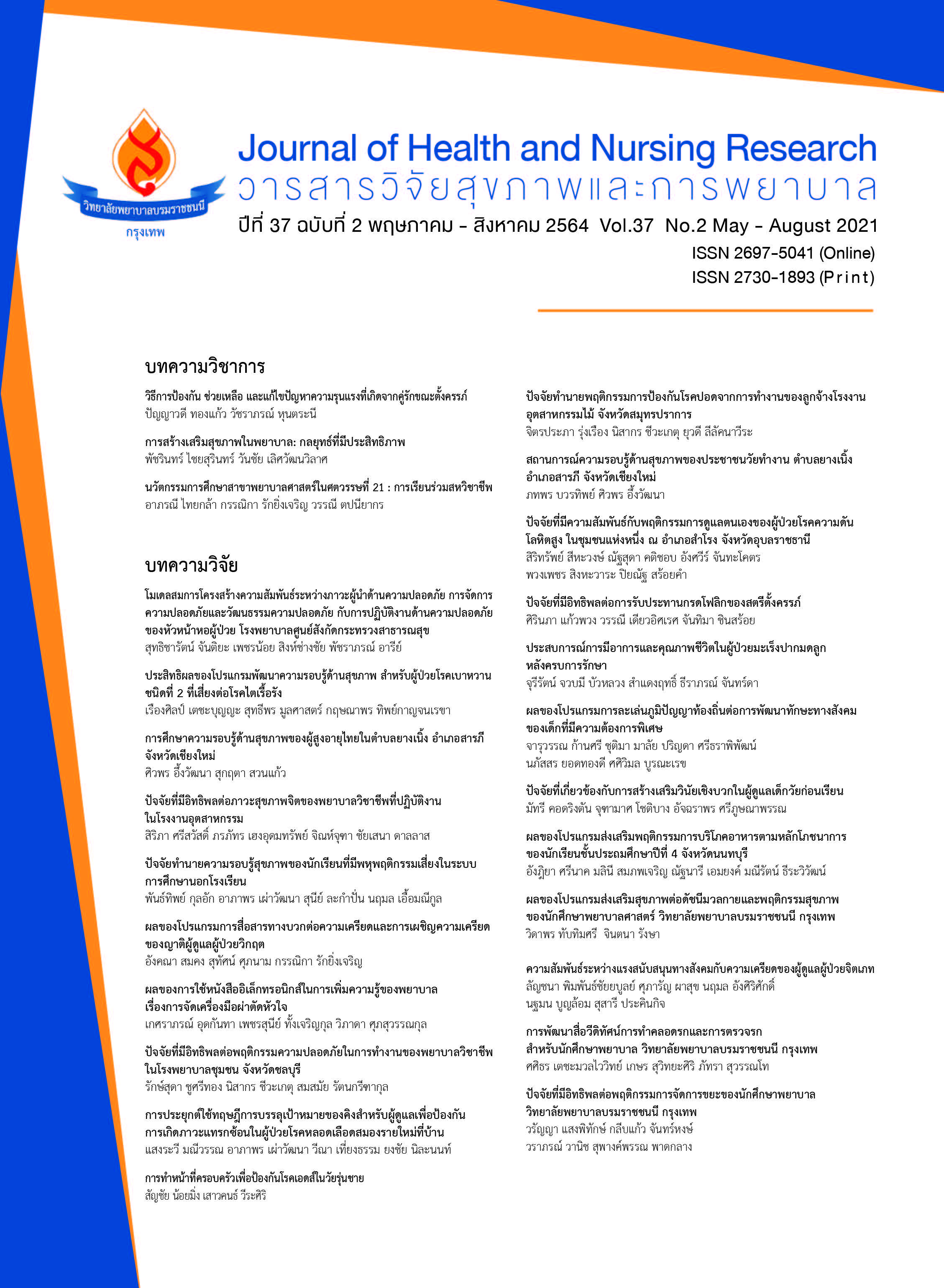ปัจจัยที่มีอิทธิพลต่อพฤติกรรมความปลอดภัยในการทำงานของพยาบาลวิชาชีพ ในโรงพยาบาลชุมชน จังหวัดชลบุรี
คำสำคัญ:
พฤติกรรมความปลอดภัย, พยาบาลวิชาชีพ, โรงพยาบาลชุมชนบทคัดย่อ
บทนำ: งานการพยาบาลเป็นงานที่หนักและพยาบาลบางส่วนจำเป็นต้องทำงานในสภาพแวดล้อมและสภาพการทำงานที่ไม่ปลอดภัยที่อาจก่อให้เกิดการเจ็บป่วยและบาดเจ็บที่เกี่ยวเนื่องจากการทำงาน วัตถุประสงค์การวิจัย: เพื่อศึกษาพฤติกรรมความปลอดภัยในการทำงาน และปัจจัยที่มีอิทธิพลต่อพฤติกรรมความปลอดภัยในการทำงานของพยาบาลวิชาชีพ ในโรงพยาบาลชุมชน จังหวัดชลบุรี ระเบียบวิธีวิจัย: กลุ่มตัวอย่าง คือ พยาบาลวิชาชีพที่ปฏิบัติการในโรงพยาบาลชุมชน จำนวน 287 คน โดยการสุ่มตัวอย่างแบบหลายขั้นตอน เครื่องมือที่ใช้ในการเก็บรวบรวมข้อมูลเป็นแบบสอบถาม ประกอบด้วย ข้อมูลทั่วไป ทัศนคติต่อพฤติกรรมความปลอดภัย ลักษณะงาน สภาพแวดล้อม นโยบายของหน่วยงาน การได้รับสนับสนุนอุปกรณ์ป้องกันอันตรายส่วนบุคคล การได้รับสนับสนุนจากหัวหน้าหรือเพื่อนร่วมงานและพฤติกรรมความปลอดภัยในการทำงาน วิเคราะห์ข้อมูลโดยใช้สถิติพรรณนา และการวิเคราะห์ถดถอยพหุคูณแบบขั้นตอน ผลการวิจัย: พบว่าพฤติกรรมความปลอดภัยในการทำงานของพยาบาลอยู่ในระดับสูง (M = 4.45, SD = 0.45) ปัจจัยที่สามารถร่วมทำนายพฤติกรรมความปลอดภัยในการทำงานของพยาบาล (BEH) อย่างมีนัยสำคัญทางสถิติ (p < .001) คือ ทัศนคติต่อพฤติกรรมความปลอดภัย (ATTI) (β = .652, p < .001) การสนับสนุนจากหัวหน้างานหรือเพื่อนร่วมงาน (SUSO) (β = .286, p < .001) สภาพแวดล้อมที่เอื้อต่อพฤติกรรมความปลอดภัย (ENVI) (β = .186, p < .001) และอายุ (AGE) (β = .054, p < .001) อำนาจการทำนายร่วมร้อยละ 40.0 (R2 = 0.40) สรุปผล: สมการทำนาย BEH = 7.88 + 0.652 (ATTI) + 0.286 (SUSO) + 0.186 (ENVI) + 0.054 (AGE) ข้อเสนอแนะ: การส่งเสริมพฤติกรรมความปลอดภัยในการทำงาน ควรเน้นส่งเสริมทัศนคติที่ดีต่อพฤติกรรมความปลอดภัย การสนับสนุนจากหัวหน้างานหรือเพื่อนร่วมงาน ตลอดจนการจัดสภาพแวดล้อมที่เอื้อต่อพฤติกรรมความปลอดภัย
Downloads
เอกสารอ้างอิง
Boonbumroe S. Work Safety behaviors of nurse in Maharat Nakhon Ratchasima hospital, Nakhon Ratchasima. The Journal of Boromarajonani College of Nursing, Nakhonratchasima 2014;20(2):82-92. (in Thai).
Chalok-kongthavorn C, Prajusilpa K. A study of work safety behavior of professional nurses, government university hospitals. Journal of Nursing Science Chulalongkorn University 2019;30(1):61-71. (in Thai).
International Safety Center. U.S. EPINet Sharps Injury and Blood and Body Fluid Exposure Surveillance
Research Group. Blood and Body Fluid Exposure Report for Jan01-Dec31 [2017]; hospitals contributing data, total exposures. [cited 2018 Jul 5]. Available from:https://internationalsafetycenter.org/wp-content/uploads/2018/10/ Official-2017-NeedleSummary.pdf
Unahalekhaka A, Lueang-a-papong S. Prevention of needlestick and sharp injuries among hospitals in Thailand. Nursing Journal 2013;40 (suppl):130-42. (in Thai)
Wongrsksat S, Sutherasan S. Associated with prevalence of needle stick or sharp injuries among nursing personnel at Thammasat University Hospital. The Journal of Thammasat University Hospital 2016;1(1):26-41. (in Thai)
Dascalaki EG. Gaglia AG. Balaras CA. Lagoudi A. Indoor environmental quality in Hellenic hospital operating rooms. Energy and Buildings.2009;41:551-60.
Opastiragul W, Chanprasit C, Kaewthummanukul T. Health status related to risk at work among professional nurses, out patient and emergency nursing section, Maharaj Nakorn Chiang Mai hospital. Nursing Journal 2015;42(2):49-61. (in Thai)
Martins A. Coelho AC. Vieira M. Matos M. Pinto ML. Age and years in practice as factors associated with needlestick and sharps injuries among health care workers in a Portuguese hospital. Accident Analysis and Prevention. 2012; 47:11–15.
Tapin J. Effects of protection on perceptions expectations and practices in needlestick or sharp injury prevention among nursing personnel in a community hospital. Thesis in of Nursing Science (Infection Control Nursing), Chiang Mai University; 2009. (in Thai)
Efstathiou G. Papastavrou E. Raftopoulos V. Merkouris A. Compliance of cypriot nurses with standard precautions to avoid exposure to pathogens. Nursing & Health Sciences. 2011;13(1):53–59.
Butprasert K, Hengpraprom S. Safety Behavior of Laboratory Workers in Medical Laboratories at A Medical School. Journal of The Police Nurse 2014;6(2):83-95. (in Thai)
Supapvanich C. Tuberculosis preventive behaviors among nursing personnel at community hospitals in Narathiwas province. The Southern College Network Journal of Nursing and Public Health. 2020:7(1);293-05. (in Thai)
Green LW, Kreuter MW. (2005). Health program planning: an educational and ecological approach (4th ed.). New York: McGraw-Hill.
Lemeshow S, Hosmer DW, Klar J, Lwanga S. Adequacy of sample size in health studies. Chichester:John Wiley & So; 1990
Bloom BS. Taxonomy of educational objectives, the classification of educational goals- handbook I: Cognitive Domain. New York: McKay; 1956.
Sawasrak K. Unahalekhaka A. Lertwatthanawilat W. Barriers to and Facilitators of Infection Prevention Practices among Professional Nurses in Tertiary Care Hospitals. Nursing Journal 2015;40(2):25-35. (in Thai)
Muralidhar S. Singh PK. Jain RK. Malhotra M. Bala M. Needle stick injuries amonghealth care workers in a tertiary care hospital of India. Indian Journal Medicine espiratory. 2010;131:405–10.
Orem DR. Nursing: Concepts of Practice (4th ed.). St. Louis: Mosby Year Book; 1991.
ดาวน์โหลด
เผยแพร่แล้ว
รูปแบบการอ้างอิง
ฉบับ
ประเภทบทความ
สัญญาอนุญาต
บทความที่ได้รับการตีพิมพ์ เป็นลิขสิทธิ์ของวารสารวิจัยสุขภาพและการพยาบาล (วิทยาลัยพยาบาลบรมราชชนนี กรุงเทพ) ไม่สามารถนำไปตีพิมพ์ซ้ำในวารสารฉบับอื่น


















